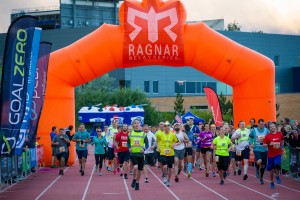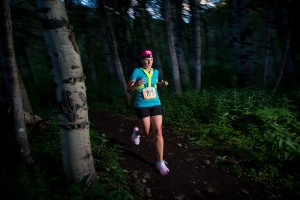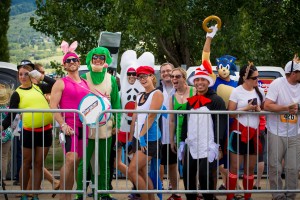A team: the idea that each member carries their weight in order to bring about the success of the whole. While the masses generally think of organized sports, namely football, basketball and baseball as ideal team sports, Ragnar Relays would like to throw its name into the mix.
The relay-race series that aims at taking teams along scenic routes and hundred-plus mile courses is a dream come true for co-founders Steve Hill, his son Dan, and Dan’s roommate Tanner Bell. And it all got started at none other than BYU.

“I wasn’t a runner by any means when Dan (Hill) and I were first developing and creating Ragnar,” Bell said. “Dan’s dad, Steve, had run several relay races, which inspired us to have that aspect to it, but we mainly wanted to create something different, something that would make running fun.”
Bell gives credit to the long hours spent with BYU faculty and mentors for the creation of Ragnar.
“We really could not have done this without the excellent staff and mentors at BYU,” Bell said. “They believed in us when others told us it was too much of an abstract and wild idea. We spent hours in the Entrepreneurship Center, where countless faculty members and volunteers advised, coached and helped us make our dream a reality.”
In 2004 their hard work and dedication paid off when the first-ever Ragnar relay race was held in Central Utah at a course titled The Wasatch Back. Ten years later, this course continues to be a popular venue for not only Ragnarians but for runners all across the state and country who decide to brave the long, challenging course. This year, more than 11,000 runners participated on more than 1,000 teams.
Today the WasatchBack is only one of 16 venues across the nation, including places in Florida, California and Illinois, to name a few.
“Obviously I love the Wasatch Back,” Bell said, who competed in this year’s competition with the professional athletes on the Cliff Bar team, which helps sponsor the race. “But all of our courses are awesome. I personally love our race in Washington, which offers some beautiful scenery as contestants run from the border of Canada to an island off the coast, and the Key West course is just awesome; it’s really one big Ragnarian party.”

Ragnar is unlike any other relay race. No participants can compete as individuals. No single runner can take home the first-place trophy with a personal best time. The race is centered around running as a team.
Participants can compete on a six-man, or the more popular 12-man team. Each team member runs three stretches of the race that varies in degree of difficulty and distance to complete the approximately 200-mile course. They run throughout the day and night; on average teams finish well after a 24-hour period. While not running, team members cheer each other on in team vans, which follow behind the one running.
“We’ve run this event six times and have participated in both the Las Vegas and Wasatch Back relays,” said Tara Morris, a mother of five and a St. George resident. “My husband and I find five other couples to run with us and love the team atmosphere and fun memories you make. My favorite part is spending time in the van together all through the night. That’s when things start to get a little funnier and slapstick than normal.”
This year’s Wasatch Back was a course that stretched from Logan to Park City, taking in six different reservoirs, the beautiful Wasatch Mountains and fields of summer wildflowers.
BYU alumni not only created the Wasatch Back course, but the BYU men’s cross-country team took first place in its division. The team finished the race in just more than 19 hours, waving BYU’s flag throughout the final stretches of the course.
Each finisher receives a T-shirt and a medal, which can double as a bottle-opener. In addition, all competitors receive apparel, food, drink and other keepsakes from the dozens of different companies that sponsor Ragnar.
“We really look for sponsors who support our runners’ aspirations and who break through all the noise of all the different running events and competitions that are out there today,” Bell said. “At every event, sponsors do giveaways that range from power bars to ice cream sandwiches and demo running watches.”
Bell continued to tell how appreciative the staff of Ragnar is to its sponsors.
Besides the obvious competition of wanting to win or finish with a good time, teams also compete and vote in the “Farout Fashion” competition that takes place at the end of every race. Contestants dress themselves and their vans in unique ways to try and take home some of the coveted Farout Fashion prizes.

“By far, my favorite team has been the team from Scipio, Utah, who have competed in the past as the Scipio Collars,” Bell said. “They dressed up as hillbillies and actually played their homemade instruments as they ran.” The team members later competed as the “Lord of the Ragnar,” where they dressed up as “Lord of the Rings” characters and competed in full costume for the entire race.
This year, Bell and Cliff Bar-sponsored athletes dressed up as Vikings as they participated in the 196-mile race as the “Cliff Barbarians.” Their vans were decorated to look like Viking ships. Bell ran alongside five local and nationally known professional athletes as well as Cliff Bar founder Gary Erickson.
“We had an absolute blast, and it was awesome to actually compete in the event again, as I’ve been too busy to participate the past couple of times,” Bell said.
Bell and Ragnar not only host an amazing relay race that continues to gain popularity and a massive fan base known as Ragnarians, but Ragnar Events, LLC is also an organization that focuses on giving back to communities throughout the nation. Through sponsor and participant donation, and with some of the money generated from yearly events, Ragnar officials have been able to donate hundreds of thousands of dollars to their “Extra Mile” program, which supports dozens of communities in ways such as building tennis courts, playgrounds and sponsoring athletic programs.
“We learned from our experience at BYU the importance and joy in giving back, and we plan on continuing to grow our charitable mission as we gain more and more popularity throughout the nation,” Bell said. “To us, running is just a by-product of Ragnar.”




